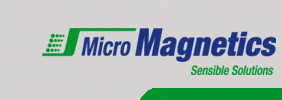Advanced Microsensor (AMS)
Advanced MicroSensors Corporation (AMS) is a semiconductor foundry, which develops and fabricates MEMS and spintronics solutions. AMS was founded in 1999 and is based in Massachusetts, USA.
AMS's magnetic sensor product line uses magnetoresistive (AMR, GMR) materials and magnetic tunnel junctions (MTJs). According to the company, their sensors exhibit excellent performance, and they outperform traditional Hall Effect devices with regard to size, power, sensitivity, accuracy and resolution.
In June 2011 Plures Technologies (which holds 95% in AMS) announced a merger with publicly traded CMSF Corporation.

 Micro Magnetics aims to advance commercial applications of spintronics and provides innovative solutions, products, and services in the areas of magnetic sensing and semiconductor metrology.
Micro Magnetics aims to advance commercial applications of spintronics and provides innovative solutions, products, and services in the areas of magnetic sensing and semiconductor metrology. Founded in 2021 as a joint spinout from the University of Glasgow and the University of Edinburgh, Neuranics develops magnetic sensors integrated with semiconductor technology for health, fitness, and metaverse applications.
Founded in 2021 as a joint spinout from the University of Glasgow and the University of Edinburgh, Neuranics develops magnetic sensors integrated with semiconductor technology for health, fitness, and metaverse applications.